Gaspard Goupy
Frozen Backpropagation: Relaxing Weight Symmetry in Temporally-Coded Deep Spiking Neural Networks
May 19, 2025Abstract:Direct training of Spiking Neural Networks (SNNs) on neuromorphic hardware can greatly reduce energy costs compared to GPU-based training. However, implementing Backpropagation (BP) on such hardware is challenging because forward and backward passes are typically performed by separate networks with distinct weights. To compute correct gradients, forward and feedback weights must remain symmetric during training, necessitating weight transport between the two networks. This symmetry requirement imposes hardware overhead and increases energy costs. To address this issue, we introduce Frozen Backpropagation (fBP), a BP-based training algorithm relaxing weight symmetry in settings with separate networks. fBP updates forward weights by computing gradients with periodically frozen feedback weights, reducing weight transports during training and minimizing synchronization overhead. To further improve transport efficiency, we propose three partial weight transport schemes of varying computational complexity, where only a subset of weights is transported at a time. We evaluate our methods on image recognition tasks and compare them to existing approaches addressing the weight symmetry requirement. Our results show that fBP outperforms these methods and achieves accuracy comparable to BP. With partial weight transport, fBP can substantially lower transport costs by 1,000x with an accuracy drop of only 0.5pp on CIFAR-10 and 1.1pp on CIFAR-100, or by up to 10,000x at the expense of moderated accuracy loss. This work provides insights for guiding the design of neuromorphic hardware incorporating BP-based on-chip learning.
Neuronal Competition Groups with Supervised STDP for Spike-Based Classification
Oct 22, 2024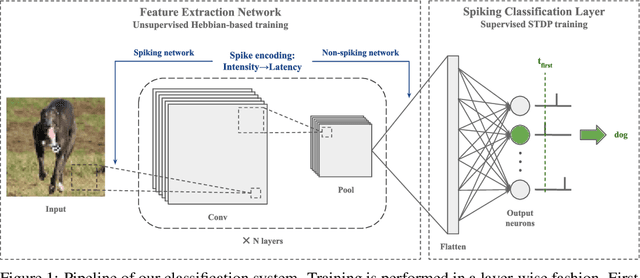
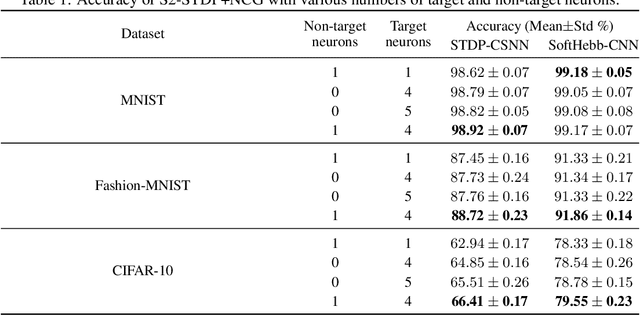
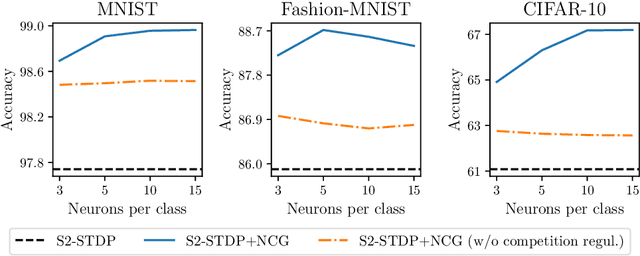

Abstract:Spike Timing-Dependent Plasticity (STDP) is a promising substitute to backpropagation for local training of Spiking Neural Networks (SNNs) on neuromorphic hardware. STDP allows SNNs to address classification tasks by combining unsupervised STDP for feature extraction and supervised STDP for classification. Unsupervised STDP is usually employed with Winner-Takes-All (WTA) competition to learn distinct patterns. However, WTA for supervised STDP classification faces unbalanced competition challenges. In this paper, we propose a method to effectively implement WTA competition in a spiking classification layer employing first-spike coding and supervised STDP training. We introduce the Neuronal Competition Group (NCG), an architecture that improves classification capabilities by promoting the learning of various patterns per class. An NCG is a group of neurons mapped to a specific class, implementing intra-class WTA and a novel competition regulation mechanism based on two-compartment thresholds. We incorporate our proposed architecture into spiking classification layers trained with state-of-the-art supervised STDP rules. On top of two different unsupervised feature extractors, we obtain significant accuracy improvements on image recognition datasets such as CIFAR-10 and CIFAR-100. We show that our competition regulation mechanism is crucial for ensuring balanced competition and improved class separation.
Paired Competing Neurons Improving STDP Supervised Local Learning In Spiking Neural Networks
Aug 04, 2023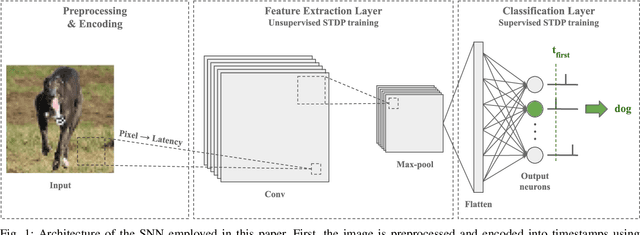
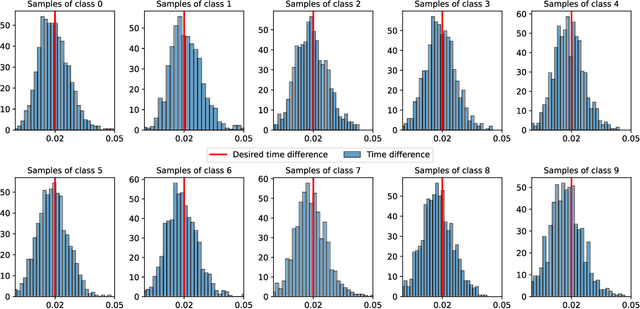
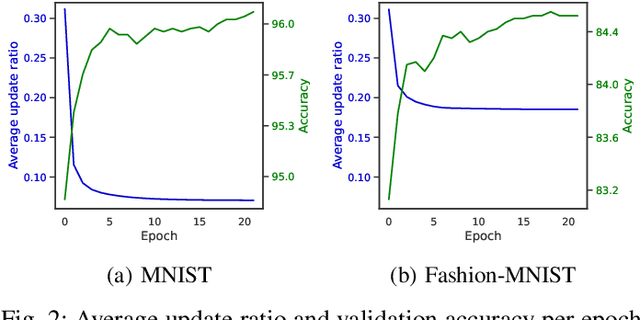
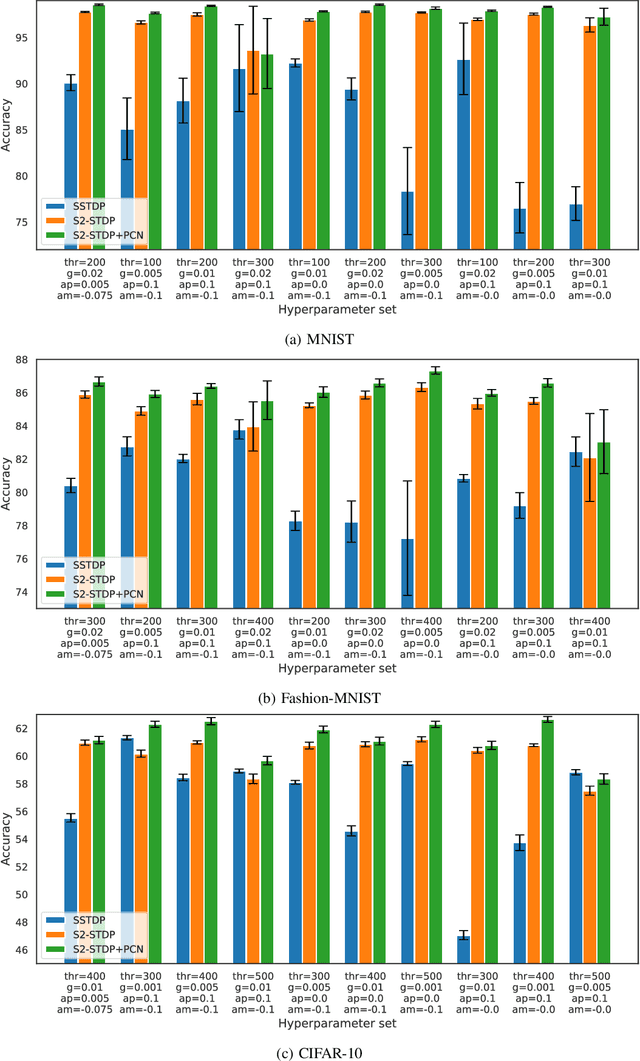
Abstract:Direct training of Spiking Neural Networks (SNNs) on neuromorphic hardware has the potential to significantly reduce the high energy consumption of Artificial Neural Networks (ANNs) training on modern computers. The biological plausibility of SNNs allows them to benefit from bio-inspired plasticity rules, such as Spike Timing-Dependent Plasticity (STDP). STDP offers gradient-free and unsupervised local learning, which can be easily implemented on neuromorphic hardware. However, relying solely on unsupervised STDP to perform classification tasks is not enough. In this paper, we propose Stabilized Supervised STDP (S2-STDP), a supervised STDP learning rule to train the classification layer of an SNN equipped with unsupervised STDP. S2-STDP integrates error-modulated weight updates that align neuron spikes with desired timestamps derived from the average firing time within the layer. Then, we introduce a training architecture called Paired Competing Neurons (PCN) to further enhance the learning capabilities of our classification layer trained with S2-STDP. PCN associates each class with paired neurons and encourages neuron specialization through intra-class competition. We evaluated our proposed methods on image recognition datasets, including MNIST, Fashion-MNIST, and CIFAR-10. Results showed that our methods outperform current supervised STDP-based state of the art, for comparable architectures and numbers of neurons. Also, the use of PCN enhances the performance of S2-STDP, regardless of the configuration, and without introducing any hyperparameters.Further analysis demonstrated that our methods exhibited improved hyperparameter robustness, which reduces the need for tuning.
 Add to Chrome
Add to Chrome Add to Firefox
Add to Firefox Add to Edge
Add to Edge